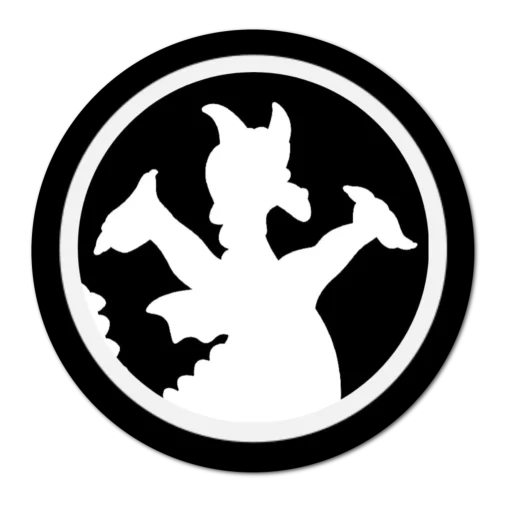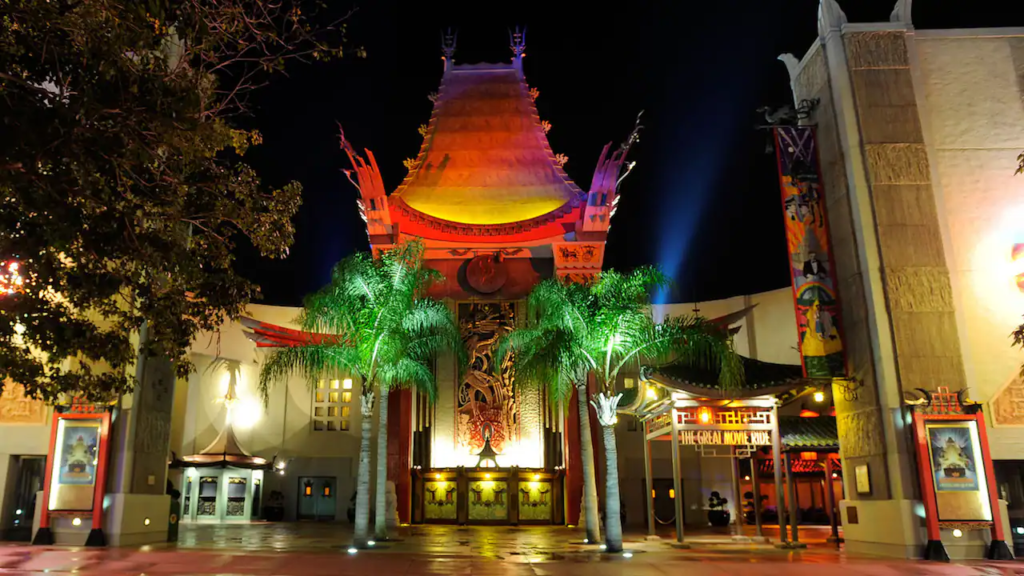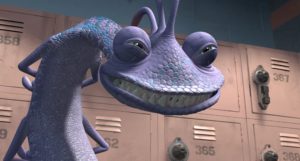(A version of this article was published for Pirates & Princesses on May 8, 2023.)
“A spectacular journey into the movies!”
The Walt Disney Company is well regarded for creating wonderful stories – in theaters, on television, in books, and at theme parks. But Disney did not create ALL of the iconic stories in film history. For this edition of Dearly Departed Disney, let’s enter Tinseltown and journey through American film history, while we hop on Disney’s legendary attraction – The Great Movie Ride.
Ride the Movies in….EPCOT?
When thinking about classic American cinema, Walt Disney World’s EPCOT Center is hardly the first place that comes to mind. But that’s exactly where the story of The Great Movie Ride begins.

EPCOT Center – based on Walt Disney’s Experimental Prototype Community of Tomorrow – opened to the public in 1982. Upon completion of the park, with its myriad of innovation and cultural expositions, Walt Disney Imagineering began concept work on new pavilion ideas to add more depth to Disney’s newest theme park. One of the new pavilion ideas was to be based on old Hollywood. It would present the glory days of American cinema, and would feature an attraction known as Great Moments at the Movies.
The idea for the pavilion didn’t fit neatly into EPCOT’s Future World or World Showcase areas, but the idea held promise, and newly-assigned Disney CEO Michael Eisner and WDI president Marty Sklar wanted to explore the concept further. The idea continued to grow. In fact, it got a whole lot larger than a simple pavilion could contain. But where to put it? That was the question that stalled the project.
Competition Down the Street
While the idea for Great Moments at the Movies was marinating within Imagineering, a game-changing development occurred in central Florida. Universal Studios – the movie giant which operated a small theme park in Universal City, CA – announced that they would be building a brand new theme park in Orlando, just a few miles away from Walt Disney World. According to Universal’s announcement, the new park would give guests on the east coast the chance to experience the movies, and catch a glimpse of life on a movie lot.
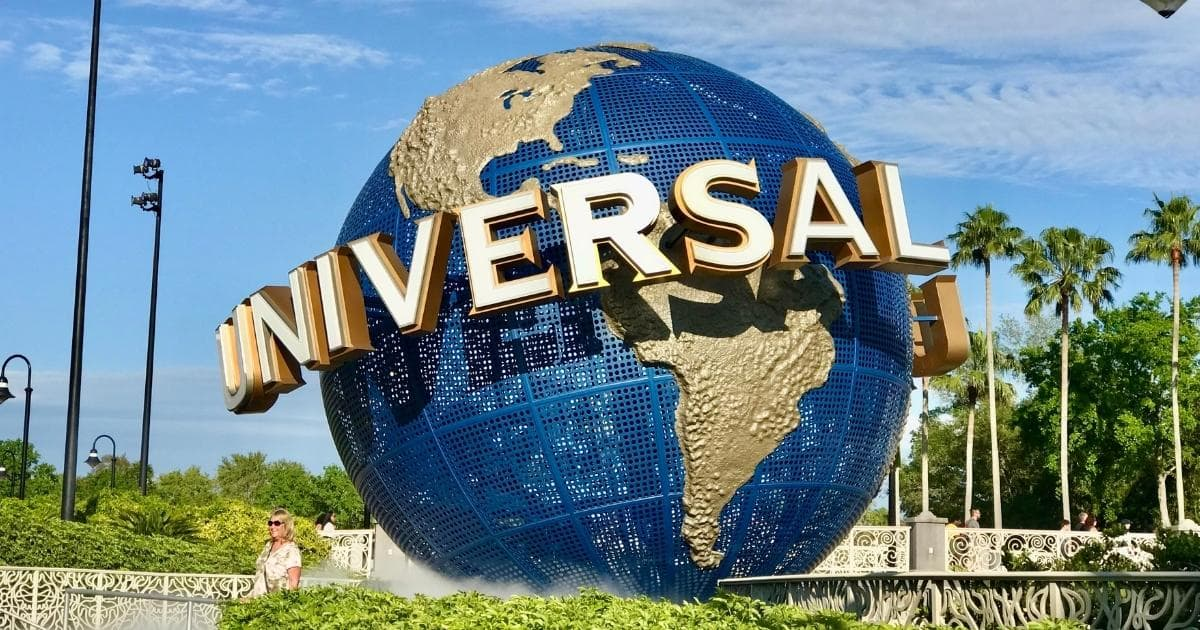
The idea of such direct competition did not sit well at all with Eisner. In response to Universal’s announcement, Eisner decided to take on Universal at their own game. The CEO fast-tracked the idea for the Hollywood Pavilion, expanded the scope, and the idea for a Hollywood-themed Disney park was born. Disney made haste in partnering with MGM Studios, and on May 1, 1989, opened Walt Disney World’s third theme park gate, called Disney-MGM Studios. In fact, Disney pulled it off a full year before Universal opened their first Orlando theme park venture!
Muppet-ational Fun Fact
Jim Henson’s Muppets have been a part of Disney for as long as many people can remember. But there was a time when that cast of colorful characters had nothing to do with the Mouse. When Disney was interested in purchasing the Muppets from Henson in the 1980s and 90s, Imagineering developed a Muppet-themed land for Disney-MGM Studios called Muppet Studios.
The land was originally going to feature two attractions. The first attraction was Muppet*Vision 3D, which we all know. As for the other attraction? The concept called for “The Great Muppet Movie Ride” – a parody of The Great Movie Ride featuring Muppet characters reenacting scenes from famous films. However, following Henson’s death in 1990, Disney’s acquisition deal fell apart. Disney still acquired the rights to the Muppets characters, but the scale of the Muppets area was reduced, including only Muppet*Vision 3D, which opened in May 1991 – about two years after the park.

Can you imagine a Muppet spin on The Great Movie Ride? It would have been an instant classic!
Is It a Film Or a Ride?
Great Moments at the Movies was originally planned to be presented by Sears Roebuck & Co. In November 1987, the one-time largest retailer in the world announced a 10-year joint marketing and licensing agreement. Under that agreement, Sears would sponsor the new studio park’s signature attraction, as well as a Hollywood Showcase store. But the agreement never came to fruition, and the Sears sponsorship opportunities were tossed in the trash bin at the back of the theater, just like that bucket containing a few unpopped popcorn kernels and a mostly-drank Coca-Cola.
Speaking of Coca-Cola, the beverage giant stepped in as the attraction’s sponsor (which seems a much better match than Sears). Shortly after the sponsor switch, the attraction was renamed The Great Movie Ride, to reflect the fact that it was a ride, not a classic movie theater experience.
The Chinese Theatre
To evoke the spirit of Hollywood films in the heart of the park, Imagineering chose to replicate one of Hollywood’s most recognizable landmarks – Grauman’s Chinese Theatre. Unlike the smaller-scale replicas of famous landmarks in other Disney parks, the Chinese Theatre facade and lobby were built full-scale, using the original building’s 1927 blueprints for construction.

Just like the original Chinese Theatre, Disney’s version has a forecourt displaying celebrity handprints, footprints, and signatures. Over 100 celebrity imprints adorn the forecourt to this day, including Audrey Hepburn, Tom Cruise, Dick Clark, Donald Duck, Michael J. Fox, Michael Jackson, Angela Lansbury, Roger Rabbit, George Lucas, and Robin Williams, among many others.
Amazingly, Audrey Hepburn – one of the biggest Hollywood legends of all time – was never invited by Grauman’s Chinese Theatre to offer her prints. She welled up in tears of joy when giving her prints to Disney, feeling both overjoyed at the honor while also hurt to have never been asked for prints in Hollywood. Upon realizing the oversight, Grauman’s asked Hepburn if she would offer her prints in Hollywood. Hepburn gracefully declined, making her prints in Disney truly unique.
Step Inside
Inside the theatre’s lobby, guests in line wound through glass display cases containing actual costumes, props, and set pieces from various films. Some of these props included Indiana Jones’ machete from Indiana Jones and the Temple of Doom, Dorothy’s ruby slippers from The Wizard of Oz, the dip machine model from Disney’s Who Framed Roger Rabbit,
Sam’s piano from Casablanca, and Mary Poppins’ carousel horse from Disney’s Mary Poppins, among many others.

In addition to film props, the lobby also featured digital posters of various motion pictures, further inviting guests to get lost in the movies. At the end of the attraction’s queue line, just prior to boarding, guests could watch a single large movie screen, which played a series of trailers for films that were featured in the attraction. This idea of foreshadowing was no stranger to Disney. Walt himself used attraction posters in the entrance tunnels beneath Disneyland’s train station to introduce guests to all the fun they would experience that day. Disneyland and Magic Kingdom both still use the practice to charming effect to this day.
Hooray for Hollywood
To take guests through a truly representative trip through the movies, Disney selected a dozen classic films spanning the genres of American cinema. Disney owned the rights to just two of the films featured in the attraction (Mary Poppins and Fantasia), and had the rights to use several more under its partnership with MGM. For the rest of the films, Disney secured separate contracts with the individual studios. Curiously (or maybe not so curiously) Disney did not feature any films from Universal Studios (that competitor opening up shop down the street).
Now boarding the attraction, up to 70 guests would sit in “traveling theater” style vehicles for their trip through the movies.
Dancing Days
First up would be a trip through the happy world of musicals. Guests passed a cake chock full of starlet dancers from the Warner Bros. film Footlight Parade. Audio animatronics took center stage for the next two films, with Gene Kelly famously swinging from a lamp post in MGM’s Singin’ in the Rain, followed by Julie Andrews and Dick Van Dyke singing from the rooftops beneath the lovely London sky in Disney’s Mary Poppins.
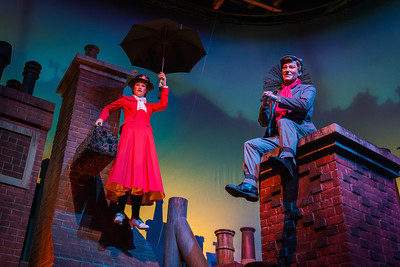
Trouble Ahead
After whistling a merry tune, guests proceeded to the dark and scary underbelly of Chicago, entering the world of gangster films. James Cagney was presented in a scene from the Warner Bros. film The Public Enemy. While in this scene, there was a good chance the guests would stumble upon a shootout between mobsters. During the commotion, a live gangster chased the tour guide out of the ride vehicle, and hijacked the vehicle (and its unsuspecting guests).
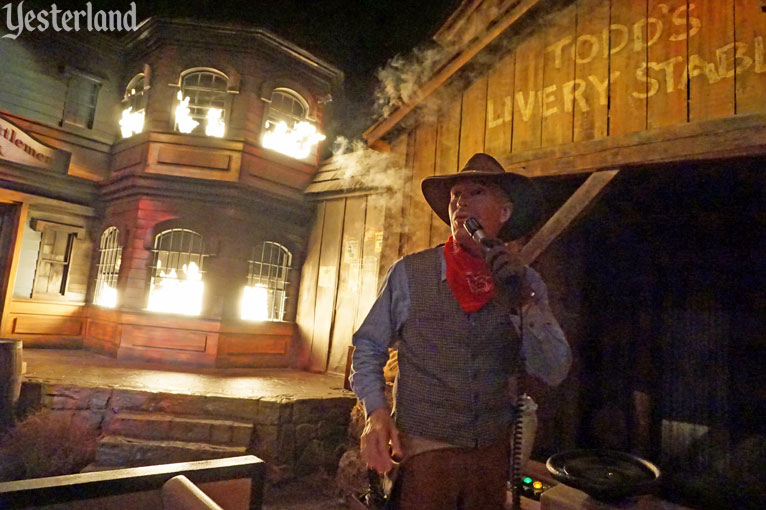
More trouble awaited in the world of westerns. Things started peacefully enough when guests encountered western film icon Clint Eastwood from the United Artists film The Man with No Name standing outside of a saloon. John Wayne from the Warner Bros. film The Searchers also sat stoically upon his horse. For those lucky guests who escaped the previous gangster scene unscathed, their luck was about to run out, as they stumbled upon a live bank robbery. During the robbery, a bad news bandit got into a shoot-out with the town sheriff, right in front of the guests! Fleeing the scene, the bandit chased the tour guide into the bank, set it ablaze with dynamite, and hijacked the ride vehicle to escape.
Narrow Escapes
At this point, guests experienced heightened anxiety as their hijacked ride vehicle – driven by either a ruthless gangster or a greedy bank robber – slunk through a frightening scene from space. Here, Sigourney Weaver nervously patrolled the silent hallways of the Nostromo spaceship from 20th Century Fox’s Alien. Hearing the warning sounds of an alien life form aboard, the hijacker sped up to avoid whatever danger may lay ahead. Of course, neither the criminal nor the guests escaped without first encountering a brush with destruction at the hands of the xenomorph alien. Considering the frightening nature of this beast, it’s hard to believe it was almost included in an attraction for Magic Kingdom’s Tomorrowland (which ultimately became ExtraTERRORestrial Alien Encounter).
After a narrow escape from space, the guests and their derelict driver found themselves in an ancient Egyptian tomb, where Indiana Jones (Harrison Ford) and his noble assistant were contemplating the “removal” of the famous Ark of the Covenant from Paramount’s Raiders of the Lost Ark.

Shortly after passing the famous archaeologist, the driver and guests entered a second room of the tomb containing a very inviting priceless artifact. Unable to subdue their greedy ambitions, the driver attempted to swipe the treasure (despite the warnings of a cloaked temple guard), only to ignite a plume of smoke and fire which completely scorched the thief. So about that cloaked figure? It was none other than the original tour guide – back in the driver’s seat to continue the journey.
Fictional Fun
From here, the tour took on a milder nature. Guests briefly sauntered by a horror scene featuring an ancient burial chamber full of mummies (some of which have come to life) before wandering into the dense jungle – home of Tarzan and Jane from MGM’s Tarzan and His Mate.
After exiting the jungle, guests witnessed a classic cinematic moment from the Warner Bros. film Casablanca, where Hollywood legends Humphrey Bogart and Ingrid Bergman greet each other in front of a waiting airplane. “Here’s looking at you kid!”
Trivia Tidbit: Guests viewing this iconic scene from Casablanca only saw the front half of the plane. The back half of this plane was separated from the front, and can be found resting along the river shoreline of Magic Kingdom’s Jungle Cruise.
Whimsy took center stage as guests neared the end of their tour. A quick drive by Sorcerer Mickey from Disney’s Fantasia was followed by a visit to Munckinland in MGM’s The Wizard of Oz. In this scene, audio-animatronic Munchkins start to peek out at guests from various hideaway spots, until the Wicked Witch of the West appears in a plume of smoke looking for her equally evil sister. But as quickly as the witch appeared, she disappeared, and guests joyfully followed the yellow brick road to the attraction’s finale scene, passing Dorothy (Judy Garland) and her friends on the way.

The attraction’s last scene sat guests in front of a large movie screen, where they viewed a goosebump-inducing three-minute film montage of classic movie moments. It was a fitting end to a tour through some of Hollywood’s most memorable films. Bravo!
“The End”
All great Hollywood stories must come to an end, and The Great Movie Ride was no exception. On July 15, 2017, Disney announced that the attraction would permanently close to make room for a replacement attraction, Mickey & Minnie’s Runaway Railway. The decision was two-fold. The more obvious reason was that the attraction overall, and more specifically the audio-animatronics within it, had become aged and outdated. Though the deeper reason for the closure was that the park – long-since renamed Disney Hollywood Studios – was undergoing a metamorphosis. The park had been slowly phasing out its studio-based demonstrations, such as the working studio portion, animation and film demonstrations, and “on-set”-style theming. While a portion of the park would remain a celebration of classic Hollywood, surrounding areas were being rethemed to offer guests stories set in more immersive film settings.
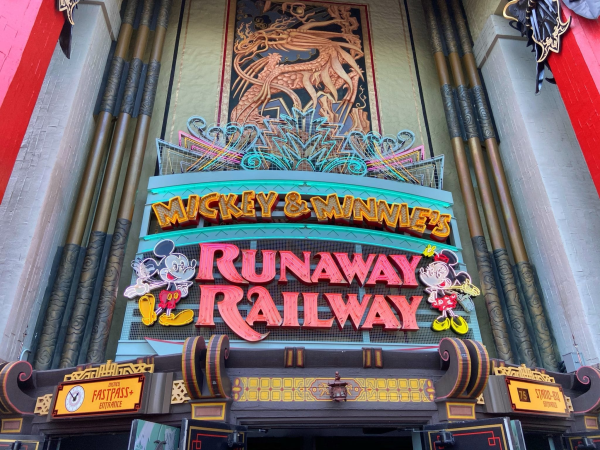
It was with a great amount of fan disappointment that the tentpole attraction of this popular Disney park took its final curtain call on August 13, 2017 – less than a month after its closure was announced.
Oscars and Easter Eggs
The Great Movie Ride may be no more, but its memory lives on – not only in the minds of adoring fans, but also in some of the thoughtful nods hidden by Disney in its successor attraction.
Mickey and Minnie’s Runaway Railway can be overwhelming to the senses. But sharp-eyed guests may spy several references to its retired predecessor, including a poster that reads “The Great Moving Ride”, found in the carnival scene between the popcorn stand and Donald’s hot dog stand. The tornado scene in the attraction includes a mailbox with the iconic “No place like home” quote from a previous attraction scene from The Wizard of Oz.
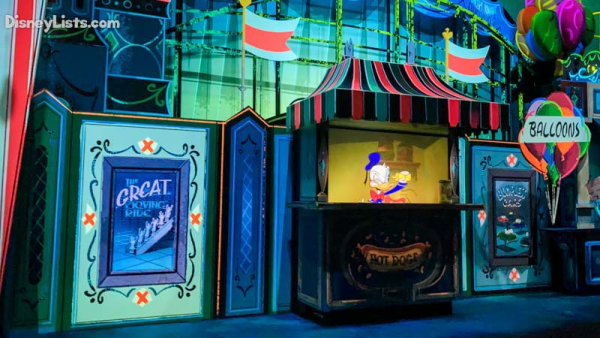
And of course, the famous Chinese Theatre facade remains intact, as an homage to Hollywood, and an icon at the center of Disney Hollywood Studios. Inside the theatre – instead of being filled with movie posters, the queue is lined with posters from Disney’s popular Mickey Mouse Shorts series.
California Dreamin’
The Great Movie Ride was so popular in Florida that Disney made several attempts to duplicate it for the west coast. The grandest plan called for the attraction to headline a proposed “Disney-MGM Studio Backlot” – a project explored in the 1980s which would have included a 40-acre studio-themed retail and entertainment district in downtown Burbank, California. Plans for that entertainment area were scrapped, as Disney put effort back into its Anaheim property instead.
Several years later, Imagineering dreamed up plans for a “Hollywoodland” area of Disneyland, which would have been added to the park during the period Michael Eisner declared the “Disney Decade” of the 1990s. Due to budget cuts, Hollywoodland was canceled, though some of its concepts were incorporated into Mickey’s Toontown, which opened in Disneyland in 1993.
Lastly, The Great Movie Ride was slated to be included in the Disney California Adventure theme park, which opened in 2001 at the Disneyland Resort. But budget cuts to the park’s original plan called for the cancellation of The Great Movie Ride. Those same budget cuts infamously resulted in the development of smaller, less expensive (and therefore, less magical) attractions – creating a pedestrian, inferior theme park Disney spent the better part of two decades rehabilitating.
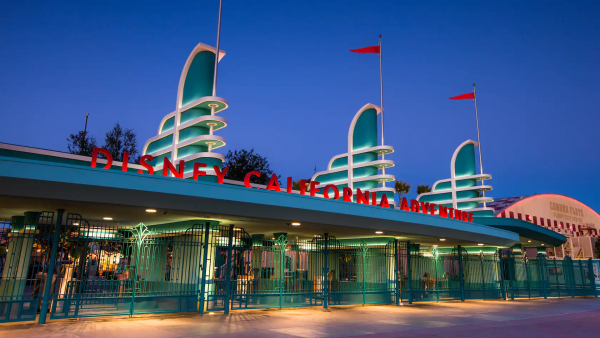
Speaking of budget cuts – The Great Movie Ride was also intended to be part of a second gate in Disneyland Paris (then known as EuroDisneyland). But initial struggles of the resort delayed the development of a second park. When the resort eventually became profitable, a second park – Walt Disney Studios Park – opened in 2002. However, it was without The Great Movie Ride, as Disney chose to include CinéMagique instead, noting a French cultural preference for shows over ride-through attractions. After all that effort, Walt Disney World remained the only place guests could once experience The Great Movie Ride.
Happy Ending?
As we’ve seen, every good Hollywood story eventually comes to an end. In the case of The Great Movie Ride, that end came around full circle, making way for the mouse who started it all.
Fans of The Great Movie Ride still lament the loss of the attraction to this day. But as Walt Disney himself once said, “Disneyland will never be completed. It will continue to grow as long as there is imagination left in the world.” Walt’s successors have taken his words to heart, and Walt’s philosophy on Disneyland holds true at every Disney park worldwide.
Disney Hollywood Studios opened in 1989 – 34 years ago – and it has been undergoing an identity change for over a decade. It is a park in transformation, where tours and exhibits are being replaced with immersive experiences. Guests can now live out their fantasy, instead of simply viewing it from afar. Where will the story of Disney Hollywood Studios go next? Only time (and Imagineers) will tell.
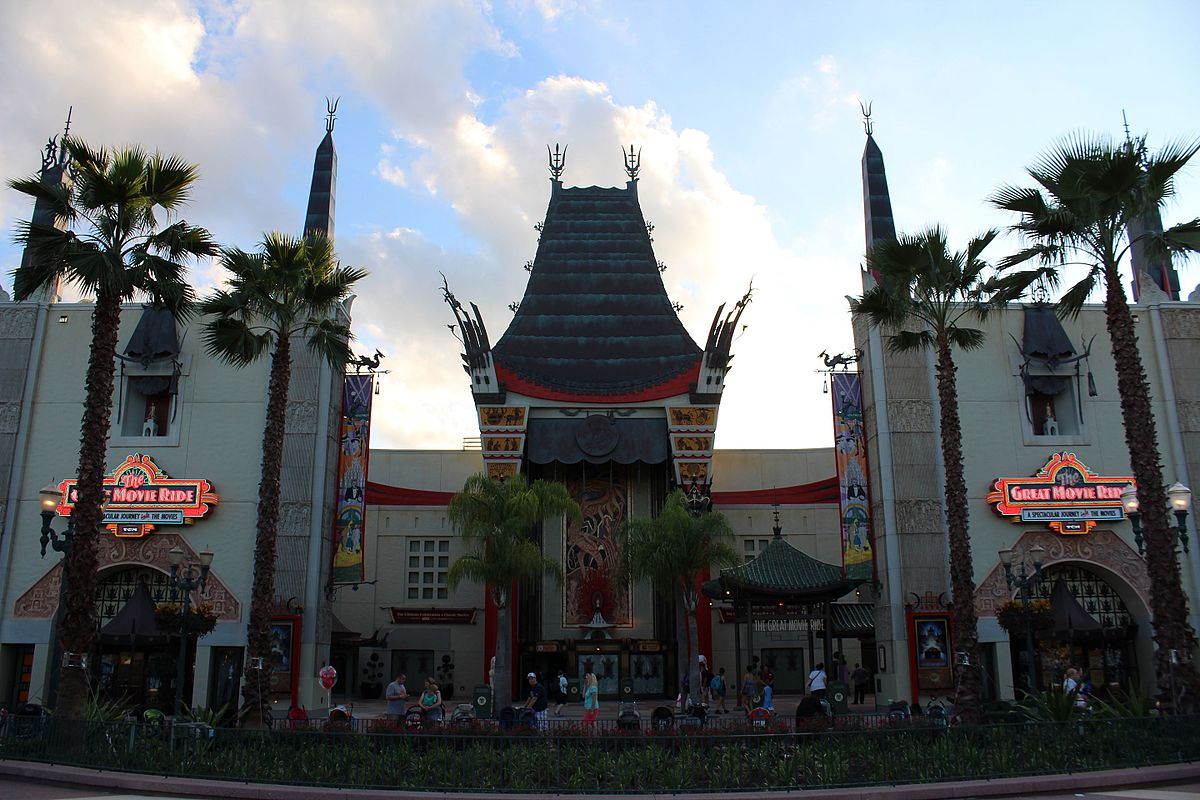
Thanks for joining us on a trip through Hollywood. Please follow along here for additional articles in this series. We’ll continue to explore many other former attractions and experiences from Walt Disney World, including Magic Kingdom, EPCOT, Hollywood Studios, and Animal Kingdom. We will also visit Disneyland and other Disney destinations!
Sources referenced in writing this article include:
Disney Extinct Attractions: The Great Movie Ride, Cole Geryak, August 13, 2017
Disney Wiki – The Great Movie Ride
Web.archive.org – Disney.com, The Great Movie Ride presented by turner Classic Movies
If you enjoyed this article, please feel free to share it with friends using one of the buttons below, or by copying/pasting the URL for this post. Also, please reach out with a comment, either here or on social media.
